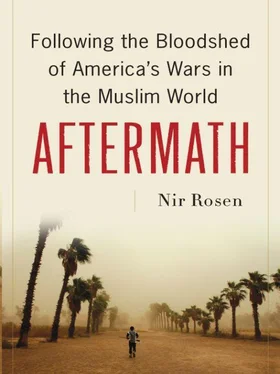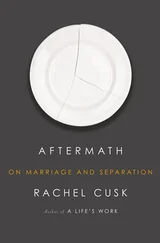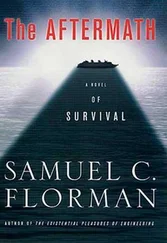Past the fortunate Iraqis who had made it out was the no man’s land between the Iraqi and Syrian borders, a desolate moonscape stretching several kilometers. Off an escarpment the cold wind battered a collection of neatly ordered tents. Three hundred and fifty Palestinian refugees were marooned here, facing extermination in Iraq but unable to enter Syria. They were refugees for the second time. Most of Iraq’s Palestinians had come from three villages—Ijzim, Jaba, and Ein Ghazal, together known as the Little Triangle—which were near Haifa in northern Palestine. As part of the plan to cleanse Israel of its Palestinians, Israeli soldiers bombarded the villages from the air, killing hundreds of civilians. Ground forces then attacked the villages and killed hundreds more civilians. The Little Triangle was defended by a motley group of farmers armed with Ottoman rifles. In July 1948 they were defeated. Many men were summarily executed, while the other inhabitants were expelled to Jenin after the Israeli soldiers relieved them of their money and jewelry and looted their villages. Other Iraqi Palestinians had come from the nearby village of Tira. In one incident, twenty-eight of Tira’s civilians were burned alive when they asked their captors for water and were doused in gasoline instead. Others had come from Ayn Hawd, which was also attacked and cleansed under orders of the Israeli leadership in 1948. Iraqi troops fighting as part of a small contingent of Arab volunteers who had come to defend the Palestinians bused them from Jenin to Iraq. By 1949 up to five thousand Palestinian refugees had been granted asylum in Iraq. A minority of Iraq’s Palestinians had lived in Kuwait from the time of their expulsion and moved to Iraq following the Gulf War, when Kuwait evicted them. By 2003 the United Nations High Commission for Refugees (UNHCR) estimated that there were up to thirty-four thousand Palestinians in Iraq. Today there are only an estimated twelve thousand left. Thousands fled using forged Iraqi passports. In at least one case, a Palestinian from Iraq landed in Cairo’s airport using an Iraqi passport. Because his body bore the scars of his torture at the hands of Iraqi militias, he was resettled with the help of UN officials in a third country.
Under Saddam the Palestinians had received subsidized housing and, in the eyes of Shiites, preferential treatment. Many of these homes were owned by Shiites. Immediately following the American invasion the Palestinians were among the first victims of reprisals by the inchoate Shiite militias. They were expelled from their homes and often ended up in tent communities or in the Baladiyat apartment complexes. The new Interior Ministry revoked the Palestinians’ identity papers. They were now obliged to register in Baghdad once a month. But to approach the Interior Ministry was to risk kidnapping, torture, and murder. The Palestinians became illegal, but they could not leave. Their neighborhoods were shelled by Shiite militias, and their men were kidnapped by Shiite death squads. They were being systematically attacked, and they were warned by Shiite leaders that they faced death in Iraq. An Iraqi diplomat in Cairo gave me the typical prejudiced view. He denied that Palestinians were being targeted, insisting that they lived better than most Iraqis. He accused them of supporting Al Qaeda and building car bombs in their neighborhoods. The U.S. State Department was pushing the Iraqi Kurds to accept the Palestinians, but Kurdish officials steadfastly refused, as did the Syrians and Jordanians. “They want to make a point that the solution for Palestinians is not settlement in the region,” a United Nations official explained to me.
In May 2006 the Palestinians began arriving at Al Tanf, on the Syrian border. Most came as families. When I visited in February 2007 there were 93 women and 135 children. In the back of the camp there was an area for single men. One tent said “Al Tanf Mosque.” That month eight Palestinians with university degrees were taken to Damascus, where they received ten days of training by the UN before returning to open a school for seventy-five children. This was controversial among some of the camp residents, who feared it would make the camp look more permanent. One tent functioned as a bakery, another as a grocery store. The residents were helped by UNHCR and Palestinian organizations in Syria. The Syrian government, already burdened with four hundred thousand Palestinian refugees and a similar number of Iraqis, was hesitant to open the door to thousands more Palestinians. Syrian officials believed that they should not be the only ones sharing the responsibility, but UN officials believed the Palestinians could be absorbed without great difficulty and that the Syrians were also making a political statement about the need to solve the Palestinian refugee crisis. But this debate came at the immediate expense of the desperate refugees, and there were five hundred more stranded on the Iraqi side of the border (known as Al Walid), protected by a local tribal sheikh but still vulnerable to the depredations of the Iraqi Security Forces, who had attacked them in the past. Iraqi Security Forces even entered Al Tanf twice attempting to kidnap people, but they failed. The camp was freezing in the winter, and rains flooded the tents and washed them away, leaving the refugees without shelter for days at a time. During the summer temperatures exceeded fifty degrees Celsius. Children suffered from diarrhea and other diseases from the dirty water. “Al Tanf is a refugee camp on a highway in between borders,” said Younes of Refugees International. “There is a lack of funds and very little assistance. People are trading their personal items with trucks for food.”
Night fell quickly on the frigid camp. In one dark tent, lit only by a small lantern, I met several men who told me their stories, their voices barely audible over the wind. Hussein, a round young man with a melancholy baby face who wore a tan Adidas tracksuit, was originally from Ein Hawd in Palestine. He had lived with his Iraqi wife and daughter in Baghdad’s Hurriya district, a Shiite militia stronghold, where he worked as a taxi driver. “In Iraq before the war we lived without problems,” he told me. “The problems started in Iraq as the American occupation began.” Hussein was first threatened in 2005, when a letter was sent to his house containing a bullet and two drops of blood. “If you do not leave Iraq, this will be your fate,” the letter said. A second death threat was signed by the Badr Brigade, the Iranian-sponsored Shiite militia. “They threatened me to leave because I am a Palestinian,” he said. “They think that because we are Palestinians the whole world helps us. But that’s not true. If we had an easy life, I wouldn’t be working as taxi driver and working in restaurants sometimes. They blew up my car. Then they blew up my house.”
Two of Hussein’s uncles had been kidnapped and tortured to death with power drills, a specialty of Iraq’s Shiite militias. The kidnappers had demanded one hundred thousand dollars in ransom, but Hussein’s family did not have the money, and the next day they received a phone call informing them that his uncles’ bodies were in the morgue. Their bodies had been mutilated: drills had been driven through their bodies from the neck to the belly, and their genitals had been cut off. Hussein’s family was given a CD with a film of the gruesome murders. “We couldn’t even have a funeral because they said, ‘If you do it we will blow you up.’ We had to bury them at night.” Hussein was also attacked in his car by a Shiite militia he believed to be the Badr Brigade; he still bore the scars. In March 2006 he heard the sounds of attackers in his house. With his wife and daughter he escaped by way of their roof to a neighbor’s roof. The attackers then blew up his house. Two months later, Hussein and his family attempted to flee to Syria after hearing rumors that it was accepting Palestinians. Stranded between the two borders, his wife’s family got her to divorce him and she returned to Baghdad.
Читать дальше











